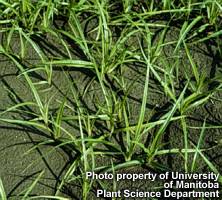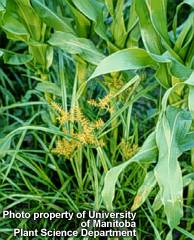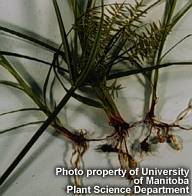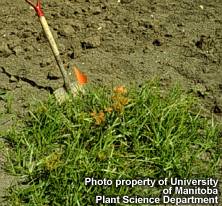Yellow Nutsedge
 |
 |
 |
 |
Biology
A perennial weed, reproducing by tubers and rhizomes, very little reproduction by seeds.. Tubers are the only plant part to overwinter. The tubers are the size of hazelnuts with pronounced brown stripes, sometimes referred to as "tiger nuts". The stems are erect, 15-76 cm tall, waxy, triangular, and unbranched. Triangular stems are characteristic of the sedge family. The leaves are grass-like, long and narrow, shiny, hairless, with closed sheaths. The flowers are brown and occur as sessile spikes in an umbel. The seeds are 3-sided achenes that are white to brown in colour.
Yellow nutsedge’s prolific growth results in a 3000-fold increase in reproductive potential during the course of one growing season. This weed thrives in moist soil, growing along river banks and is spread by flood water and cultivation. It is not controlled by most commonly used herbicides.
Scouting Techniques
Take a minimum of 20 weed counts across a field. Check low lying moist areas for patches of this weed.
Effects On Crop Quality
Decreases crop quality and increases production costs due to increased cultivation and hand weeding.
Threshold/Yield Loss
As a result of competition, this weed can considerably reduce crop yields.
Control Tips
- commence cultivation as soon as tubers start sprouting in spring,
- ensuring no new tubers form
- seasonal control with Group 6 Bentazon (Basagran)
